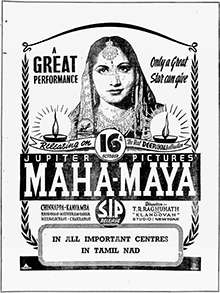Mahamaya (film)
Mahamaya (transl. The great illusion) is a 1944 Indian Tamil-language historical drama film directed by T. R. Raghunath with P. U. Chinnappa, P. Kannamba, M. G. Chakrapani, N. S. Krishnan and T. A. Mathuram in the lead roles. It was released on 16 October 1944.
| Mahamaya | |
|---|---|
 Theatrical release poster | |
| Tamil | மஹாமாயா |
| Directed by | T. R. Raghunath Elangovan |
| Produced by | M. Somasundaram S. K. Mohideen |
| Screenplay by | Elangovan |
| Story by | Elangovan |
| Starring | P. U. Chinnappa P. Kannamba |
| Music by | S. V. Venkatrama Iyer K. S. Venkatarama Iyer |
| Cinematography | Marcus Bartley |
| Edited by | A. Kasilingam |
Production company | |
| Distributed by | South India Pictures |
Release date |
|
Running time | 11,000 ft. |
| Country | India |
| Language | Tamil |
Plot
Mahamaya, the princess of the kingdom of Gandhara and Vikram, the prince of a neighbouring kingdom happen to be pupils of the same teacher (Guru). Mahamaya garlands the sword of Vikram without knowing its implication. When a woman garlands a man's sword, according to the custom prevailed in those times, it is considered that she has become the wife of the sword owner. Vikram knows about her action. After they leave the Ashram of the teacher each marry a different person. Later, Vikram happens to meet Mahamaya. Reminding her that she has chosen him as her husband, he claims that she belongs to him. However, Mahamaya rejects his claim. Vikram abducts Mahamaya but she manage to escape from him. When she goes home, her husband refuses to accept her. Abandoned, Mahamaya kills her child and commits suicide.[1]
Cast
|
|
- Female dancers[2]
- K. Varalakshmi, T. Rajbala, V. Rajeswari, K. Rajarajeswari, K. S. Sarojini, M. S. Santha, J. Kanni.
Production
The film was jointly produced by M. Somasundaram and S. K. Mohideen, and directed by T. R. Raghunath and Elangovan; the latter also wrote the screenplay.[2] Cinematography was handled by Marcus Bartley and the film's operative cameraman was Jiten Banerji. Editing was done by A. Kasilingam and audiography by Dinshaw K. Tehrani. Art was handled by F. Nagoor and choreography by M. Meenakshisundaram Pillai and Pandit Bholonath Sharma.[2] Elangovan took almost a year to complete the screenplay. He was not sure how to end the story, so he wrote three endings and left the decision to the producers and the director; all three endings were filmed. The film was shot at Newton Studios.[3]
Soundtrack
Music was composed by S. V. Venkatrama Iyer and K. S. Venkatarama Iyer while the lyrics were written by T. K. Sundara Vathiyar and Kambadasan.[2] Though there were 10 songs in the film only one ‘Silaye nee ennidam sung by P. U. Chinnappa was a hit.[3]
Release and reception
Mahamaya was released on 16 October 1944, and distributed by South India Pictures.[4] Although the film was acclaimed by critics for the acting by Kannamba and Chinnappa, audiences at that time did not accept the story because it shows a king going after another person's wife. Therefore, the film did not do well at the box office.[3]
References
- Rajadhyaksha, Ashish; Willemen, Paul, eds. (1998) [1994]. Encyclopaedia of Indian Cinema (PDF). Oxford University Press. pp. 301–302. ISBN 0-19-563579-5.
- Mahamaya (song book) (in Tamil). M. Saminathan. 1944.
- Guy, Randor (4 September 2010). "Mahamaya 1944". The Hindu. Archived from the original on 21 January 2017. Retrieved 12 October 2016.
- "Maha-Maya". The Indian Express. 16 October 1944. p. 7.